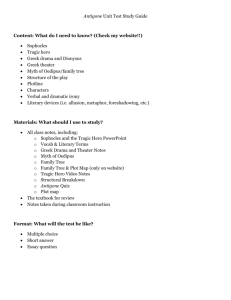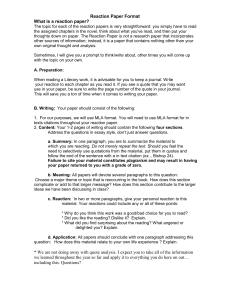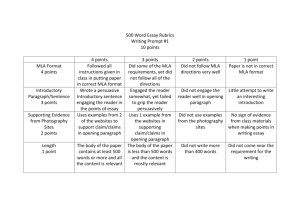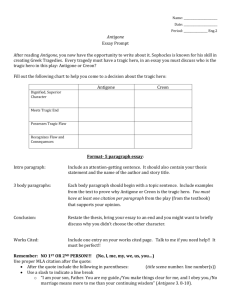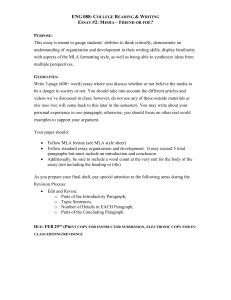Antigone Essay Prompts
advertisement
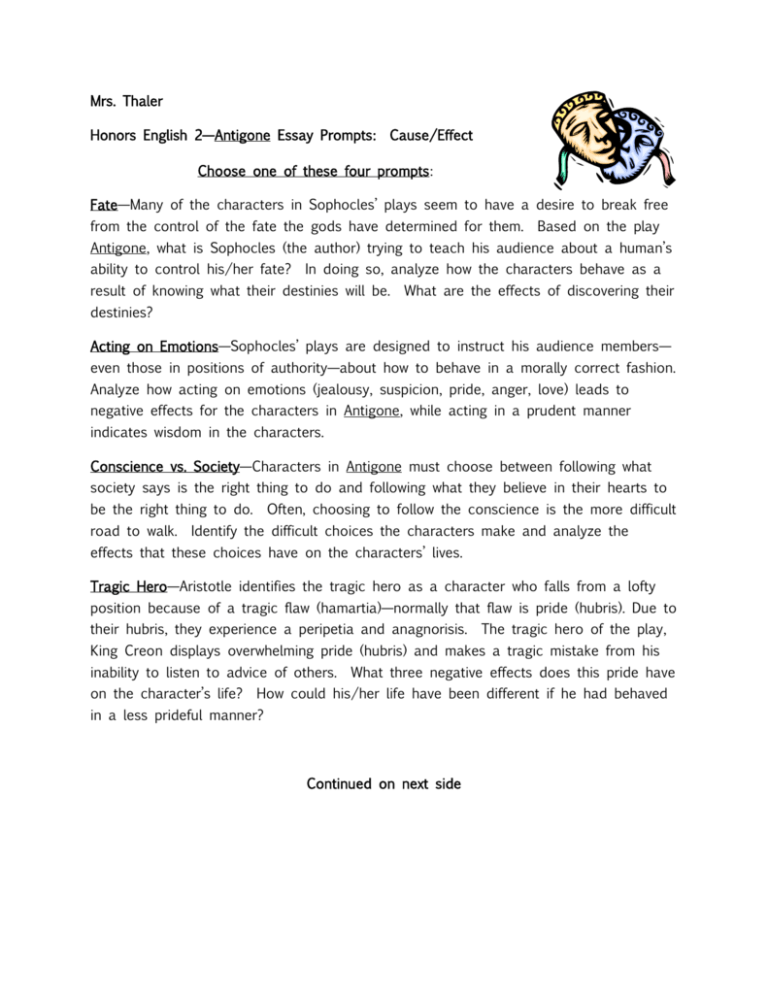
Mrs. Thaler Honors English 2—Antigone Essay Prompts: Cause/Effect Choose one of these four prompts: Fate—Many of the characters in Sophocles’ plays seem to have a desire to break free from the control of the fate the gods have determined for them. Based on the play Antigone, what is Sophocles (the author) trying to teach his audience about a human’s ability to control his/her fate? In doing so, analyze how the characters behave as a result of knowing what their destinies will be. What are the effects of discovering their destinies? Acting on Emotions—Sophocles’ plays are designed to instruct his audience members— even those in positions of authority—about how to behave in a morally correct fashion. Analyze how acting on emotions (jealousy, suspicion, pride, anger, love) leads to negative effects for the characters in Antigone, while acting in a prudent manner indicates wisdom in the characters. Conscience vs. Society—Characters in Antigone must choose between following what society says is the right thing to do and following what they believe in their hearts to be the right thing to do. road to walk. Often, choosing to follow the conscience is the more difficult Identify the difficult choices the characters make and analyze the effects that these choices have on the characters’ lives. Tragic Hero—Aristotle identifies the tragic hero as a character who falls from a lofty position because of a tragic flaw (hamartia)—normally that flaw is pride (hubris). Due to their hubris, they experience a peripetia and anagnorisis. The tragic hero of the play, King Creon displays overwhelming pride (hubris) and makes a tragic mistake from his inability to listen to advice of others. What three negative effects does this pride have on the character’s life? How could his/her life have been different if he had behaved in a less prideful manner? Continued on next side Do not use 1st or 2nd person POV—(NO I think, I feel…, Me, My opinion, I will, or You). Instead, use the objective 3rd person (people, one, the reader, the audience, etc.) Do not use words that are vague (stuff, very, good/bad, nice, things) or like, so…, slang (That’s totally awesome! Creon is so boss), verbs like got or get, or conditionals like “maybe”. Type in MLA, size 12 font, double-space, 1 inch margins; include a creative title, introduction, body, and conclusion. Mandatory. (See MLA handout if you need support here). All writers must use 2 quotes in each body paragraph in the CD position, embedded properly using the TLQ (transition, lead-in, quote) method. Cite quotes properly in MLA formatting. (See packet for help here). Do not start a body paragraph with a quote. Use a variety of appropriate transitional phrases Use at least 5 Marker Verbs (see handout) to improve our verb choices. “A-Level-commentary” avoids the obvious, and rather makes astute observations and connections. ***Include a Works Cited page. No Works Cited, no credit. Submit to www.turnitin.com when requested for credit. NO SUBMIT? No credit. Effect—noun--something that is produced by an agency or cause; result; consequence: Exposure to the sun had the effect of toughening his skin Affect--verb--. af·fect·ed, af·fect·ing, af·fects. 1. To have an influence on or effect a change in: Inflation affects the buying power of the dollar. To Grammar Girl's MLA (MODERN LANGUAGE ASSOCIATION) FORMATTING FOR PAPERS: Please follow this format when typing up a paper for our English class. See template on CHS library home page. All papers are double spaced throughout. No extra spacing—such as triple or more spacing in-between paragraphs or elsewhere on the page. Type in a size 12, Times New Roman or similar font. Margins are 1” all around the page. Your computer is set to this default. MODEL: Smith 1 Sammy Smith Mrs. Thaler English 3/Period 4 8 September 2008 The Adventures of an “A” Student Many students think it is not possible for them to ace their exams or to earn a perfect score on a paper, but it is entirely in their own hands. Whether a student chooses to pay attention to due dates, use their day planner, and do their homework is 5 Paragraph Essay Shaping Sheet I. Creative Title: ____________________________________ Introduction (4-5 sentences) A. Opener (Universal Idea, meaningful quote, thought-provoking idea, creative description…) __________________________________________________________________ __________________________________________________________________ __________________________________________________________________ B. Transition (short intro. to story line, Title, Author, Genre) __________________________________________________________________ __________________________________________________________________ C. Thesis (topic/opinion—three parts—identify specifically what you are proving, be persuasive) __________________________________________________________________ __________________________________________________________________ __________________________________________________________________ II. Body Paragraph #1 A.(TS)_______________________________________________________________ _________________________________________________________ B.(CD)_______________________________________________________________ _________________________________________________________ C.(CM)_______________________________________________________________ _________________________________________________________ D.(CM)______________________________________________________________ _________________________________________________________ E.(CD)_______________________________________________________________ _________________________________________________________ F.(CM)_______________________________________________________________ _________________________________________________________ G.(CM)______________________________________________________________ _________________________________________________________ H.(CS)_______________________________________________________________ _________________________________________________________ III. Body Paragraph #2 A.(TS)_______________________________________________________________ _________________________________________________________ B.(CD)_______________________________________________________________ _________________________________________________________ C.(CM)_______________________________________________________________ _________________________________________________________ D.(CM)______________________________________________________________ _________________________________________________________ E.(CD)_______________________________________________________________ _________________________________________________________ F.(CM)_______________________________________________________________ _________________________________________________________ G.(CM)______________________________________________________________ _________________________________________________________ H.(CS)_______________________________________________________________ _________________________________________________________ IV. Body Paragraph #3 A.(TS)_______________________________________________________________ _________________________________________________________ B.(CD)_______________________________________________________________ _________________________________________________________ C.(CM)_______________________________________________________________ _________________________________________________________ D.(CM)______________________________________________________________ _________________________________________________________ E.(CD)_______________________________________________________________ _________________________________________________________ F.(CM)_______________________________________________________________ _________________________________________________________ G.(CM)______________________________________________________________ _________________________________________________________ H.(CS)_______________________________________________________________ _________________________________________________________ V. Conclusion (restate thesis, draw conclusions, make insightful observations, relate to the real world…4-5 sentences). ______________________________________________________________________________ ______________________________________________________________________________ ______________________________________________________________________________ ______________________________________________________________________________ ______________________________________________________________________________ ______________________________________________________________________________ ______________________________________________________________________________ ______________________________________________________________________________ ______________________________________________________________________________ ______________________________________________________________________________ ______________________________________________________________________________ Five-Paragraph Essay Grading Rubric I. Mrs. Thaler MLA a. Heading (Name, Teacher, Class/Period, Date) (4) b. Header correct (2) c. Title—creative, unique, not underlined (2) d. Margins, font size (2) /10 II. Introduction a. Hook/Introductory technique is engaging, effective b. Title, Author, Genre included c. Three-part-thesis is effectively worded, complete & PROVES something, persuasive /10 III. Body Paragraphs a. Topic Sentences are effective (5) b. CDs(quotes) embedded using TLQ method (10) c. Transitional statements are used in variety (5) d. Two quotes in each body as evidence, solid examples (5) e. Commentary is in-depth, reflects about example (20) Explains significance/avoids obvious& vague statements f. Concluding sentences are effective, present (5) /50 IV. Conclusion a. Restates thesis in new terms b. Broadens topic, connects idea to real world, big picture /10 V. Conventions/6-Traits a. Edited for punctuation, capitalization, grammar, usage, spelling b. Citations correct/Works Cited Page present, MLA format correct c. Verb tense is present tense, avoids passive tense d. Voice is strong and engaging; appropriate e. Vocabulary is advanced and appropriate, avoids “banned words” and contractions/Being verbs replaced when possible f. Avoids 1st and 2nd person pronouns (I/You/We) /20 TOTAL: P /100 WORKS CITED /20


